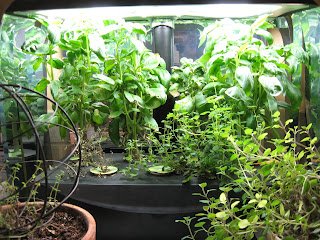For the past couple years I have hydroponically grown basil indoors during the winter months.
I bake with it, put it in sandwiches, add it to omelets, and give plenty away.
It is one of the easiest Herbs to grow indoors.
It is one of the easiest Herbs to grow indoors.
The one thing I never thought of using it for is SOAP! Not until I ran across Suzanne McMinn's blog, 'Chickens in the Road' ,did I have a 'Daaaaaa' moment! Why not Basil in soaps.....I have plenty of it!
So, that is where I am doing today!
For my Lavender Basil Soap I used:
For my Lavender Basil Soap I used:
Coconut Oil
Cottonseed Oil
Olive Oil
Soybean Oil
Sunflower Oil
and
Lard
&
Lavender Essential Oil
&
Lavender Essential Oil
I also wanted to put some color into this soap.
I infused the Sunflower Oil with some dried, crushed Basil and Kelp Powder.
(color of the oils)
I wanted a nice green color, but you never know the exact color it will end up to be until it goes through the gel stage.
I left the Kelp power and the crushed Basil leaves in the soap
for a specked look.
I put some Titanium Dioxide in some of the batter to get a whiter
color for the top of the soap.
Here is what it looks like before I cut it.
(color of the oils)
I wanted a nice green color, but you never know the exact color it will end up to be until it goes through the gel stage.
I left the Kelp power and the crushed Basil leaves in the soap
for a specked look.
I put some Titanium Dioxide in some of the batter to get a whiter
color for the top of the soap.
Here is what it looks like before I cut it.
This is what it looked like cut.
As you can see, the green went to a very pale green.
ValerieAnn























